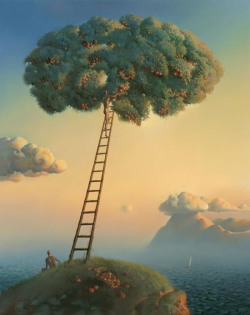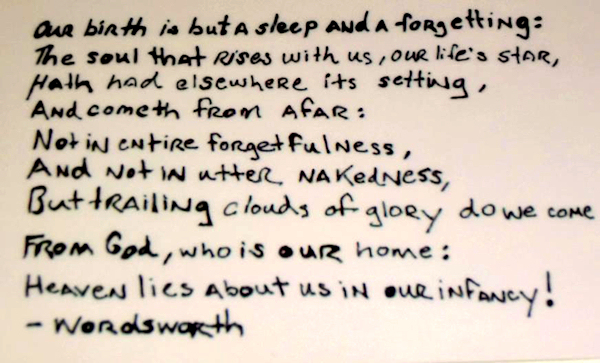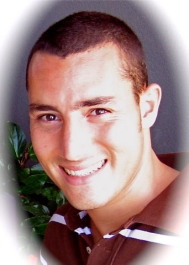A Tribute to Christopher R. Al-Aswad

In the last incomplete essay that Chris wrote before his passing, he explored his dream of blending visual and litereray arts through this online journal. Though unfinished and almost in note form, Chris’s distinctive voice shines through. It is reproduced below, incomplete as it was found.
When Visual Art Becomes Poetry
The complex inter-relationship between literary art and visual art is like an enigma to me.
This is not an intellectual puzzle I’m trying to figure out in my early 30′s. This is my life. This is what Escape into Life, online arts journal, embodies: the fusion of two types of media; art and literature; and the urge to discover what happens when a journal allows both forms to meld and grow as an organic whole.
pEscape into Life aims to explore, enmesh, and mostly, to uncover the core similarities of the two through the growth and development of technology, community, and inquiry.
At the most basic level, there’s poetry and there’s visual art; separate and distinct forms of artistic expression. Nonetheless–the history of visual art and the history of literature reflect each other to such a degree that it would seem visual artists and poets are made from the same
It’s more like an intuition has grown over the years. Undoubtedly, my parents, my upbringing, my talents and lack thereof, contributed to these two equally strong influences in my life. Mixed exposure to both literary and visual art.
Escape into Life, online arts journal, is basically a new media experiment to blend, meld, mesh, mingle, interrelate, bind, juxtapose, and interpenetrate the two forms of art.
The best comparison is to a scholar or a scientist who comes to discover that their life-work revolves around a single theme.
Of course, there is reason for my interest in this subject of art and literature; and how they remain separate and distinct and yet intricately enmeshed. My mother was an oil-painter, I was exposed to art at an early age, and I was brought up in her creative shadow.
–and a life-long exploration of mine–that fuels the very online arts journal you are reading right now, called Escape into Life.
I have no philosophy or common goal I wish to convert our readers to. There is no academic bent or political ideology behind this journal.
Escape into Life pushes the boundaries of visual art, literature, and poetry.

Essays by Chris Al-Aswad
Chris published his writing online under his pen name Lethe Bashar. Lethe Bashar is also the lead character he used in the Novel of Life. Chris wrote the Novel of Life as a “recording”, a fictional history of his adolescence, to have a more comprehensive understanding of the past. He wrote 22 chapters in all. A continuance of the Novel of Life is Las Vegas, a graphic novel completed with 61 chapters. He also was writing The Book of Innocence, better known as The Blog of Innocence. These were chapters of his “present” life as it happened beginning in the year 2008. Chris intended to publish four volumes of essays online but he only published the two below.
Taking Off the Mask – Essays Volume I
Sentimental Education: Essays in Art – Volume II
More of Chris’s writing can be found in his Collected Essays.
p
Poems by Chris Al-Aswad
The Pleasures are Fleeting
 the pleasures are fleeting,
the pleasures are fleeting,on some days you’re wondering
if they even exist
but in the slow station
of all our lives, a moment of being
comes and goes, lingers for awhile
out of a plateau, pleasures rise
this wondrous hot spring
fills you with momentary delight
and even the thoughts you are thinking
echo with reason and brilliance
and even the coffee tastes incredibly rich
so you want more of the experience
and less of the waiting, I suggest
a simple remedy, I suggest
breathing, maybe taking a break with me
on the pier, we’ll sit and listen to
the waves crash
p
The Swan of my Youth
I awoke in the middle of a summer night,To see her resting outside my window,Reposing on a patch of lilacs, crashedFlowers under her sparse plumage, looking out-of-place,And out-of-time, depleted after many summersOf migrating between the many lakes,Searching for food or friendship or refuge fromThe ill-tempered geese.Unfurling her long neck, she assumed the pale moon,And conveyed her solemn song with dignity.My mother painted a self-portraitThat now hangs in my apartment,I am staring at that painting now,Remembering how, in her final days,She retreated into her room,And held herself there--above all of nature--Without the taint of fear.I remember when I rushed into her room, cryingHow she poised herself,Without a single feather stirring.
Anxious child beating in my heart
the anxious child beating in my heart is you furious whirling child of discontent and love you disentangle with grace never losing touch with unmistakable anguish you fall belatedly to the bottom of the world
a cycle will remake you as a cycle broke you down and all your thoughts about the world won't matter
i'm young again with you i'm blind and naked and undefeated anxious child come dance with me
what are you afraid of only lovers speak this way what are you running from timid infant on a wave
the dark engulfing world will cower behind you and me
Read more of Chris's poetry in Collected Poems , and in his e-book Purposeless Solitude – Selected Poems by Lethe Bashar
Podcasts by Chris Al-Aswad
In addition to his Blog of Innocence podcast, Chris started a YouTube channel in 2008 to explore and share what he had learned through his life experiences. Among the topics he wanted to talk about were poetry, philosophy and writing. In the video below, Chris talks about the characters in Dead Souls, a Russian novel by Nikolai Gogol.
The following is an excerpt Chris wrote in his own handwriting, from Ode: Intimations of Immortality from Recollections of Early Childhood by William Wordsworth.
From all of us who follow and love Escape into Life, thank you Chris, for everything.
















